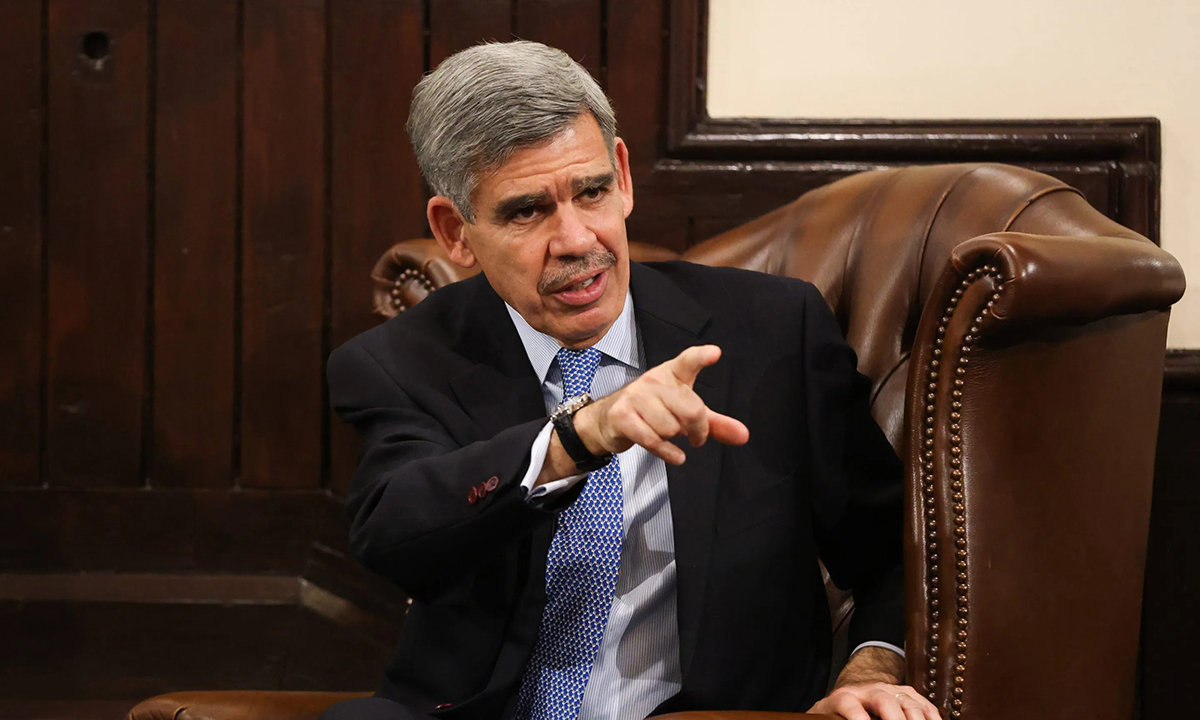
投资者和经济学家们都在发出经济衰退的警告。但一位重量级的经济学家几个月来不断发出警告信号,他认为这次经济衰退可能与我们以往所经历的经济衰退不同。
这位经济学家就是穆罕默德·埃尔-埃里安,他曾经是具有巨大影响力的债券市场参与者太平洋投资管理公司(PIMCO)的首席执行官,还曾经担任美国前总统贝拉克·奥巴马的全球发展委员会(Global Development Council)的主席,并且出版了多本经济学畅销书。简而言之,他是目前在世的最优秀的美联储(Federal Reserve)和市场观察家之一,而且他并不喜欢目前的状况。
埃尔-埃里安在为《外交事务》(Foreign Affairs)撰写的一篇评论文章中称,有一种倾向认为经济挑战是“临时的,并且会快速逆转”。他提到了美联储初期的想法,即高通胀是暂时性的,或者认为经济衰退持续时间较短这种共识。
他说:“全世界不只是处在经济衰退的边缘,而是正在经历一场影响深远的经济和金融巨变。”
埃尔-埃里安提到的一种经济理论指出,当一个经济周期达到自然终点而下一个周期尚未真正开始时,会发生经济衰退。但他表示,这一次的情况并不是“经济车轮”又一次转动的结果,因为他认为全世界正在经历的巨变将“延长现有经济周期的期限”。他重点提到了三个趋势,表明全球经济正在经历巨变。
改变全球经济的三个重要趋势
埃尔-埃里安称,第一个变革性趋势是从需求不足向供应不足转变。第二个趋势是央行停止提供无限流动性支持。第三个趋势是金融市场变得日益脆弱。
他写道,这三个趋势能够解释“过去几年的许多异常经济变化”。他预测未来经济冲击“会变得更加频繁和猛烈”,经济不确定性将持续增加。他还表示,分析师们还没有意识到这一点。
第一个转变受到新冠疫情的影响,首先是整个系统突然停滞,然后政府提供刺激或者埃尔-埃里安所说的“慷慨大派送”,导致“需求激增,远高于供应”。
埃尔-埃里安指出,随着时间的推移,逐渐暴露出供应问题的“根源不只是新冠疫情”。俄乌冲突及其导致的制裁和地缘政治紧张以及新冠疫情导致的普遍用工荒,都与供应问题有关。供应链的中断为“近岸外包”创造了条件。近岸外包是一种永久转变,即公司将生产业务搬到距离母国更近的地区,而不是重建2019年的供应链。这从本质上表明“全球化的性质”发生了改变。
埃尔-埃里安说:“更糟糕的是,全球经济格局的变化,恰逢各国央行从根本上调整政策的时候。”埃尔-埃里安几个月来一直批评美联储行动过于迟缓,没有尽早认识到美国经济已经出现恶性通胀,后来只能通过大幅加息来弥补损失的时间。
随着通胀骤升,美联储进行了激进加息,过去四次每次均加息75个基点,使美联储基金利率进入3.75%至4%的区间。但埃尔-埃里安认为,这种政策方法的根本性变化引发了第三个问题。“市场意识到,美联储正在艰难弥补损失的时间,并且开始担心美联储会继续维持高利率,可能对经济有害。结果就是金融市场动荡。”
他表示,市场已经习惯了央行的低息贷款,这种变化所产生的“反常效应”是“全球大量金融活动”涌入资产管理、私募股权和对冲基金等受监管程度较低的实体。自今年低息贷款时代结束以来出现的市场波动,可以理解为大量金融活动正在寻找值得投资的新目标。目前的金融市场非常脆弱。
他说:“金融体系的脆弱增加了央行工作的难度。美联储现在面对的不止是普通的两难境地,即如何在避免伤害经济增长和就业的情况下降低通胀,它要面对的是三大难题,分别是:如何降低通胀、如何保护经济增长和就业,以及如何保证金融稳定。”
不只埃尔-埃里安在就全球经济未来发出一系列警告。资深经济学家努里埃尔·鲁比尼和金融历史学家亚当·图兹也警告全球经济面临相互关联的威胁。鲁比尼最近出版了一本新书《超级威胁》(MEGATHREATS),分析了全球面临的10多个严重经济问题,而图兹则用“多重危机”(polycrisis)“来形容一系列相互关联的复杂问题”,让这个词为世人所知。
鲁比尼最近曾经对《财富》杂志表示,他和图兹描述了一系列类似现象,但他并未就埃尔-埃里安的批评发表意见。然而,与埃尔-埃里安一样,鲁比尼解释说,目前全球经济受到多个因素的影响,而且由于各因素之间相互关联,因此产生了一种多米诺骨牌效应,可能导致经济衰退。
鲁比尼告诉《财富》杂志:“加息可能导致股市、债券市场、信用市场和资产价格整体崩溃,反过来造成更多的金融和经济损失。”但他解释称,加息确实有助于应对通胀,尽管加息可能导致硬着陆,而这一切都是因为对供应链的“负面冲击”。
埃尔-埃里安总结道,未来,这些变化意味着经济结果将变得更难预测。而且经济结果并不一定意味着会是一个简单的结果,而是一种“级联效应”(cascading effect)的体现,即一件坏事可能导致其他坏事发生。(财富中文网)
译者:刘进龙
审校:汪皓
投资者和经济学家们都在发出经济衰退的警告。但一位重量级的经济学家几个月来不断发出警告信号,他认为这次经济衰退可能与我们以往所经历的经济衰退不同。
这位经济学家就是穆罕默德·埃尔-埃里安,他曾经是具有巨大影响力的债券市场参与者太平洋投资管理公司(PIMCO)的首席执行官,还曾经担任美国前总统贝拉克·奥巴马的全球发展委员会(Global Development Council)的主席,并且出版了多本经济学畅销书。简而言之,他是目前在世的最优秀的美联储(Federal Reserve)和市场观察家之一,而且他并不喜欢目前的状况。
埃尔-埃里安在为《外交事务》(Foreign Affairs)撰写的一篇评论文章中称,有一种倾向认为经济挑战是“临时的,并且会快速逆转”。他提到了美联储初期的想法,即高通胀是暂时性的,或者认为经济衰退持续时间较短这种共识。
他说:“全世界不只是处在经济衰退的边缘,而是正在经历一场影响深远的经济和金融巨变。”
埃尔-埃里安提到的一种经济理论指出,当一个经济周期达到自然终点而下一个周期尚未真正开始时,会发生经济衰退。但他表示,这一次的情况并不是“经济车轮”又一次转动的结果,因为他认为全世界正在经历的巨变将“延长现有经济周期的期限”。他重点提到了三个趋势,表明全球经济正在经历巨变。
改变全球经济的三个重要趋势
埃尔-埃里安称,第一个变革性趋势是从需求不足向供应不足转变。第二个趋势是央行停止提供无限流动性支持。第三个趋势是金融市场变得日益脆弱。
他写道,这三个趋势能够解释“过去几年的许多异常经济变化”。他预测未来经济冲击“会变得更加频繁和猛烈”,经济不确定性将持续增加。他还表示,分析师们还没有意识到这一点。
第一个转变受到新冠疫情的影响,首先是整个系统突然停滞,然后政府提供刺激或者埃尔-埃里安所说的“慷慨大派送”,导致“需求激增,远高于供应”。
埃尔-埃里安指出,随着时间的推移,逐渐暴露出供应问题的“根源不只是新冠疫情”。俄乌冲突及其导致的制裁和地缘政治紧张以及新冠疫情导致的普遍用工荒,都与供应问题有关。供应链的中断为“近岸外包”创造了条件。近岸外包是一种永久转变,即公司将生产业务搬到距离母国更近的地区,而不是重建2019年的供应链。这从本质上表明“全球化的性质”发生了改变。
埃尔-埃里安说:“更糟糕的是,全球经济格局的变化,恰逢各国央行从根本上调整政策的时候。”埃尔-埃里安几个月来一直批评美联储行动过于迟缓,没有尽早认识到美国经济已经出现恶性通胀,后来只能通过大幅加息来弥补损失的时间。
随着通胀骤升,美联储进行了激进加息,过去四次每次均加息75个基点,使美联储基金利率进入3.75%至4%的区间。但埃尔-埃里安认为,这种政策方法的根本性变化引发了第三个问题。“市场意识到,美联储正在艰难弥补损失的时间,并且开始担心美联储会继续维持高利率,可能对经济有害。结果就是金融市场动荡。”
他表示,市场已经习惯了央行的低息贷款,这种变化所产生的“反常效应”是“全球大量金融活动”涌入资产管理、私募股权和对冲基金等受监管程度较低的实体。自今年低息贷款时代结束以来出现的市场波动,可以理解为大量金融活动正在寻找值得投资的新目标。目前的金融市场非常脆弱。
他说:“金融体系的脆弱增加了央行工作的难度。美联储现在面对的不止是普通的两难境地,即如何在避免伤害经济增长和就业的情况下降低通胀,它要面对的是三大难题,分别是:如何降低通胀、如何保护经济增长和就业,以及如何保证金融稳定。”
不只埃尔-埃里安在就全球经济未来发出一系列警告。资深经济学家努里埃尔·鲁比尼和金融历史学家亚当·图兹也警告全球经济面临相互关联的威胁。鲁比尼最近出版了一本新书《超级威胁》(MEGATHREATS),分析了全球面临的10多个严重经济问题,而图兹则用“多重危机”(polycrisis)“来形容一系列相互关联的复杂问题”,让这个词为世人所知。
鲁比尼最近曾经对《财富》杂志表示,他和图兹描述了一系列类似现象,但他并未就埃尔-埃里安的批评发表意见。然而,与埃尔-埃里安一样,鲁比尼解释说,目前全球经济受到多个因素的影响,而且由于各因素之间相互关联,因此产生了一种多米诺骨牌效应,可能导致经济衰退。
鲁比尼告诉《财富》杂志:“加息可能导致股市、债券市场、信用市场和资产价格整体崩溃,反过来造成更多的金融和经济损失。”但他解释称,加息确实有助于应对通胀,尽管加息可能导致硬着陆,而这一切都是因为对供应链的“负面冲击”。
埃尔-埃里安总结道,未来,这些变化意味着经济结果将变得更难预测。而且经济结果并不一定意味着会是一个简单的结果,而是一种“级联效应”(cascading effect)的体现,即一件坏事可能导致其他坏事发生。(财富中文网)
译者:刘进龙
审校:汪皓
Investors and economists have been sounding the recession alarm. But one major economist who has seen warning signs mounting for many months says this potential recession is unlike what we’re used to.
That economist is Mohamed El-Erian, previously the chief executive officer of the massively influential bond-market player PIMCO. He also chaired former President Barack Obama’s Global Development Council and has written several economic best-sellers. Simply put, he’s one of the best Federal Reserve and markets watchers alive, and he hasn’t liked what he’s seen for some time now.
There’s a tendency to see economic challenges as “temporary and quickly reversible,” El-Erian wrote in a commentary for Foreign Affairs, citing the Federal Reserve’s initial thought that high inflation would be transitory or the consensus that a recession could be short.
“The world isn’t just teetering on the brink of another recession,” he continued. “It is in the midst of a profound economic and financial shift.”
He referenced economic theory that a recession occurs when a business cycle reaches its natural endpoint and before the next cycle really takes flight, but he said this time won’t be one more turn of the “economic wheel,” as he sees the world experiencing major changes that “will outlast the current business cycle.” He highlighted three trends that suggest a transformation in the global economy is under way.
Three major trends transforming the world economy
The first transformational trend, El-Erian says, is the shift from insufficient demand to insufficient supply. The second is the end of boundless liquidity from central banks. And the third is the growing fragility of financial markets.
These help to explain “many of the unusual economic developments of the last few years,” he wrote, and looking forward he sees even more uncertainty as economic shocks “grow more frequent and more violent.” Analysts aren’t waking up to this yet, he added.
The first shift was driven by the effects of the pandemic, beginning with the entire system coming to a halt and stimulus from the government, or what El-Erian called “enormous handouts,” causing “demand surges well ahead of supply.”
But as time went on, El-Erian said, it became clear that the issue of supply “stemmed from more than just the pandemic.” It’s tied to Russia’s invasion of Ukraine that resulted in sanctions and geopolitical tensions, along with a widespread labor shortage brought forward by the pandemic. These disruptions in supply chains gave way to “nearshoring,” a more permanent shift of companies moving their production closer to home, rather than a reconstruction of the 2019-era supply chain. This essentially reflects a change in the “nature of globalization.”
“Making matters worse, these changes in the global economic landscape come at the same time that central banks are fundamentally altering their approach,” El-Erian said. As he has been for months now, El-Erian criticized the Federal Reserve in particular for being too slow to recognize inflation entrenching itself into the economy, and then for its steep rate hikes to make up for lost time.
As inflation soared, the Fed pivoted to aggressive rate hikes—with the last four increases all being by 75 basis points that lifted the federal funds rate to a range of 3.75% to 4%. But this fundamental change in approach led to the third problem, El-Erian writes. “Markets recognized that the Fed was scrambling to make up for lost time and started worrying that it would keep rates higher for longer than would be good for the economy. The result was financial market volatility.”
Markets have been trained to expect easy money from central banks, he said, and the “perverse effect” of that has been for “a significant chunk of global financial activity” to flood into asset management, private equity and hedge funds, among other less-regulated entities. The gyrations in markets since the easy money era ended this year can be understood as that significant chunk looking for a new home, investment-wise. It’s fragile at this point.
“The fragility of the financial system also complicates the job of central banks,” he said. “Instead of facing their normal dilemma—how to reduce inflation without harming economic growth and employment—the Fed now faces a trilemma: how to reduce inflation, protect growth and jobs, and ensure financial stability.”
El-Erian isn’t alone in citing multiple threats to the future of the world economy. The veteran economist Nouriel Roubini and the financial historian Adam Tooze are two other prominent voices warning of interrelated threats. Roubini has just authored a new book called “MEGATHREATS” about no fewer than 10 giant economic problems facing the world, while Tooze has popularized the term “polycrisis” to describe a group of related and compounding problems.
Roubini himself told Fortune recently that he and Tooze are describing a similar set of phenomena, although he did not touch on El-Erian’s criticisms. However, like El-Erian, Roubini explained the multiple factors at play, and because they’re so interconnected, it creates a domino-like effect, contributing to a possible recession.
“If you raise interest rates, you can also have a crash of equity markets, bond mark credit markets, and asset prices in general that causes further financial and economic damage,” Roubini told Fortune. Still, he explained that raising rates does help fight inflation, even though it risks the possibility of a hard landing, all of which are triggered by “negative shocks” to the supply chain.
Moving forward, El-Erian concluded, these changes mean economic outcomes will be harder to predict. And it won’t necessarily mean one simple outcome but rather a reflection of a “cascading effect”—in that one bad event could likely lead to another.






